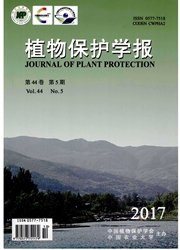

 中文摘要:
中文摘要:
为明确萝卜、白菜和油菜对小菜蛾实验种群特征的影响,测定了小菜蛾对3种寄主的取食量,通过构建两性生命表比较了不同寄主植物对其实验种群发育与繁殖的影响,并综合生命表与取食量参数,评价了小菜蛾对萝卜、白菜和油菜的危害。结果显示:小菜蛾幼虫在萝卜、油菜和白菜上的取食量差异显著,分别为93.3、105.0和114.7 mg/头。小菜蛾取食萝卜、白菜和油菜后,其幼虫的发育历期差异显著,依次为8.6、8.5和7.6 d;种群内禀增长率依次为0.18、0.23和0.23,周限增长率为1.19、1.26和1.26,净生殖率为18.7、46.1和30.6。取食萝卜的小菜蛾各发育阶段的存活率最低。小菜蛾对各供试寄主实际危害量占理论危害量的百分比为油菜(71.8%)】白菜(70.8%)】萝卜(53.0%)。表明同一时间内,小菜蛾对油菜危害程度最大,白菜次之,萝卜最小。
 英文摘要:
英文摘要:
In order to determine the influences of three host plants (radish,Chinese cabbage and non-heading Chinese cabbage) on the traits of experimental population of the diamondback moth,Plutella xylostella (L.) (Lepidoptera:Putellidae),the development and reproduction of P.xylostella population were studied based on the age-stage two-sex life tables under three food conditions.The food consumption of P.xylostella larvae on the three host plants was determined,and the damage of P.xylostella on the three host plants was evaluated based on a composite index of food consumption with life table parameters.The results showed that the food consumption of P.xylostella larvae significantly differed among radish,non-heading cabbage and Chinese cabbage,which were 93.3,105.0 and 114.7 mg per larva,respectively.The developmental durations of larvae fed on radish,Chinese cabbage and non-heading Chinese cabbage were 8.6,8.5,7.6 d,respectively.The intrinsic rates of increase were 0.18,0.23 and 0.23,and the finite rates of increase were 1.19,1.26 and 1.26,and the net reproductive rates were 18.7,46.1 and 30.6,respectively.Survival rate of larvae fed on radish was the lowest.The damage rates of larvae were in the following order:non-heading Chinese cabbage (71.8%) > Chinese cabbage (70.8%) > radish (53.0%).The results implied that the damage degree of P.xylostella on non-heading Chinese cabbage was the highest,Chinese cabbage the moderate,and radish the lowest.
 同期刊论文项目
同期刊论文项目
 同项目期刊论文
同项目期刊论文
 期刊信息
期刊信息
